window TOYOTA HIGHLANDER 2020 Accessories, Audio & Navigation (in English)
[x] Cancel search | Manufacturer: TOYOTA, Model Year: 2020, Model line: HIGHLANDER, Model: TOYOTA HIGHLANDER 2020Pages: 402, PDF Size: 18.72 MB
Page 127 of 402
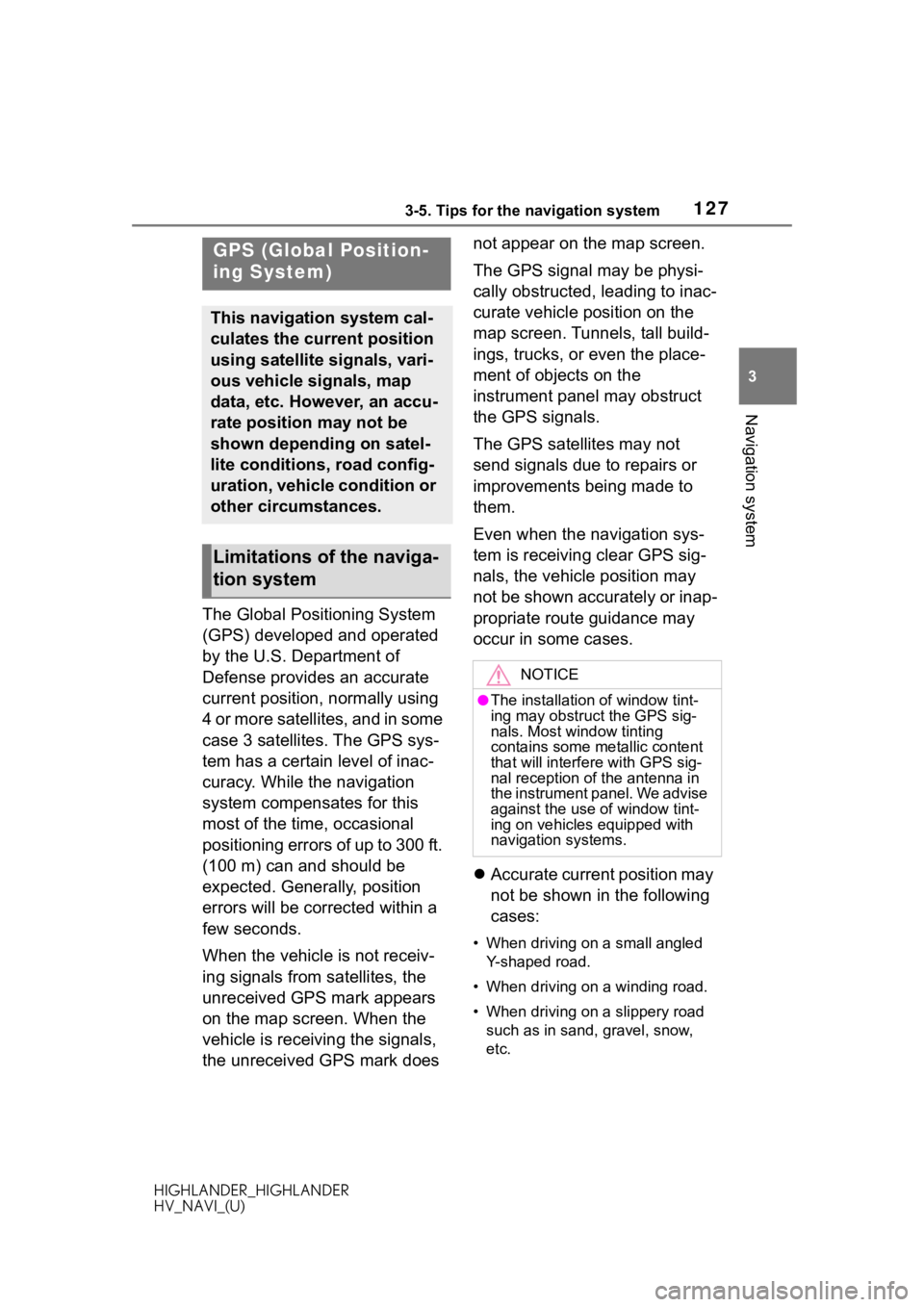
1273-5. Tips for the navigation system
HIGHLANDER_HIGHLANDER
HV_NAVI_(U)
3
Navigation system
3-5.Tips for the navigation system
The Global Positioning System
(GPS) developed and operated
by the U.S. Department of
Defense provides an accurate
current position, normally using
4 or more satellites, and in some
case 3 satellites. The GPS sys-
tem has a certain level of inac-
curacy. While the navigation
system compensates for this
most of the time, occasional
positioning errors of up to 300 ft.
(100 m) can and should be
expected. Generally, position
errors will be corrected within a
few seconds.
When the vehicle is not receiv-
ing signals from satellites, the
unreceived GPS mark appears
on the map screen. When the
vehicle is receiving the signals,
the unreceived GPS mark does not appear on the map screen.
The GPS signal may be physi-
cally obstructed, leading to inac-
curate vehicle position on the
map screen. Tunnels, tall build-
ings, trucks, or even the place-
ment of objects on the
instrument panel may obstruct
the GPS signals.
The GPS satellites may not
send signals due to repairs or
improvements being made to
them.
Even when the navigation sys-
tem is receiving clear GPS sig-
nals, the vehicle position may
not be shown accurately or inap-
propriate route guidance may
occur in some cases.
Accurate current position may
not be shown in the following
cases:
• When driving on a small angled
Y-shaped road.
• When driving on a winding road.
• When driving on a slippery road such as in sand, gravel, snow,
etc.
GPS (Global Position-
ing System)
This navigation system cal-
culates the current position
using satellite signals, vari-
ous vehicle signals, map
data, etc. However, an accu-
rate position may not be
shown depending on satel-
lite conditions, road config-
uration, vehicle condition or
other circumstances.
Limitations of the naviga-
tion system
NOTICE
●The installation of window tint-
ing may obstruct the GPS sig-
nals. Most window tinting
contains some metallic content
that will interf ere with GPS sig-
nal reception of the antenna in
the instrument panel. We advise
against the use of window tint-
ing on vehicles equipped with
navigation systems.
Page 169 of 402
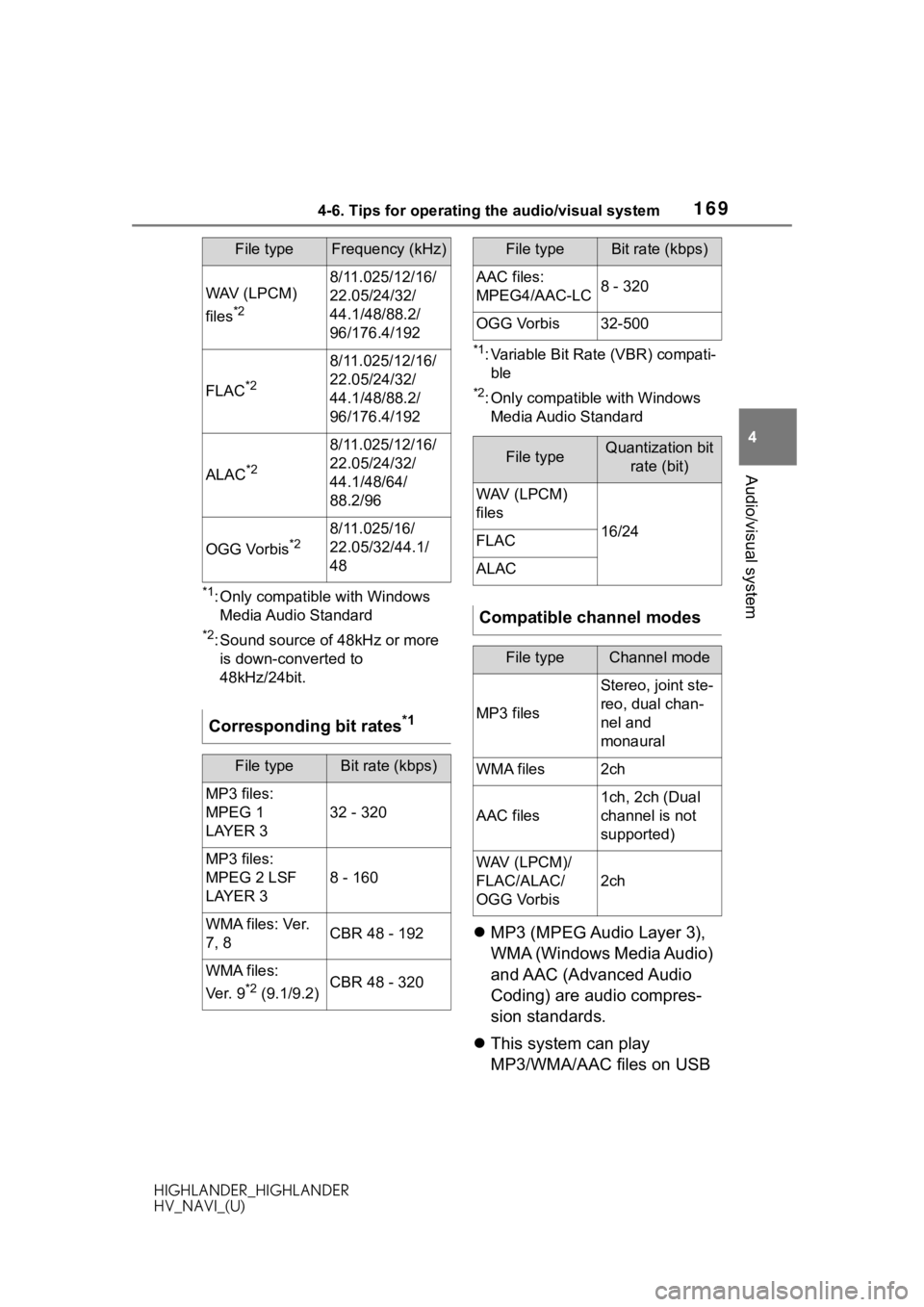
1694-6. Tips for operating the audio/visual system
HIGHLANDER_HIGHLANDER
HV_NAVI_(U)
4
Audio/visual system
*1: Only compatible with Windows Media Audio Standard
*2: Sound source of 48kHz or more is down-converted to
48kHz/24bit.
*1: Variable Bit Rate (VBR) compati-ble
*2: Only compatible with Windows Media Audio Standard
MP3 (MPEG Audio Layer 3),
WMA (Windows Media Audio)
and AAC (Advanced Audio
Coding) are audio compres-
sion standards.
This system can play
MP3/WMA/AAC files on USB
WAV (LPCM)
files
*2
8/11.025/12/16/
22.05/24/32/
44.1/48/88.2/
96/176.4/192
FLAC*2
8/11.025/12/16/
22.05/24/32/
44.1/48/88.2/
96/176.4/192
ALAC*2
8/11.025/12/16/
22.05/24/32/
44.1/48/64/
88.2/96
OGG Vorbis*28/11.025/16/
22.05/32/44.1/
48
Corresponding bit rates*1
File typeBit rate (kbps)
MP3 files:
MPEG 1
LAYER 3
32 - 320
MP3 files:
MPEG 2 LSF
LAYER 3
8 - 160
WMA files: Ver.
7, 8CBR 48 - 192
WMA files:
Ver. 9
*2 (9.1/9.2)CBR 48 - 320
File typeFrequency (kHz)
AAC files:
MPEG4/AAC-LC8 - 320
OGG Vorbis32-500
File typeQuantization bit
rate (bit)
WAV (LPCM)
files
16/24FLAC
ALAC
Compatible channel modes
File typeChannel mode
MP3 files
Stereo, joint ste-
reo, dual chan-
nel and
monaural
WMA files2ch
AAC files
1ch, 2ch (Dual
channel is not
supported)
WAV (LPCM)/
FLAC/ALAC/
OGG Vorbis
2ch
File typeBit rate (kbps)
Page 172 of 402
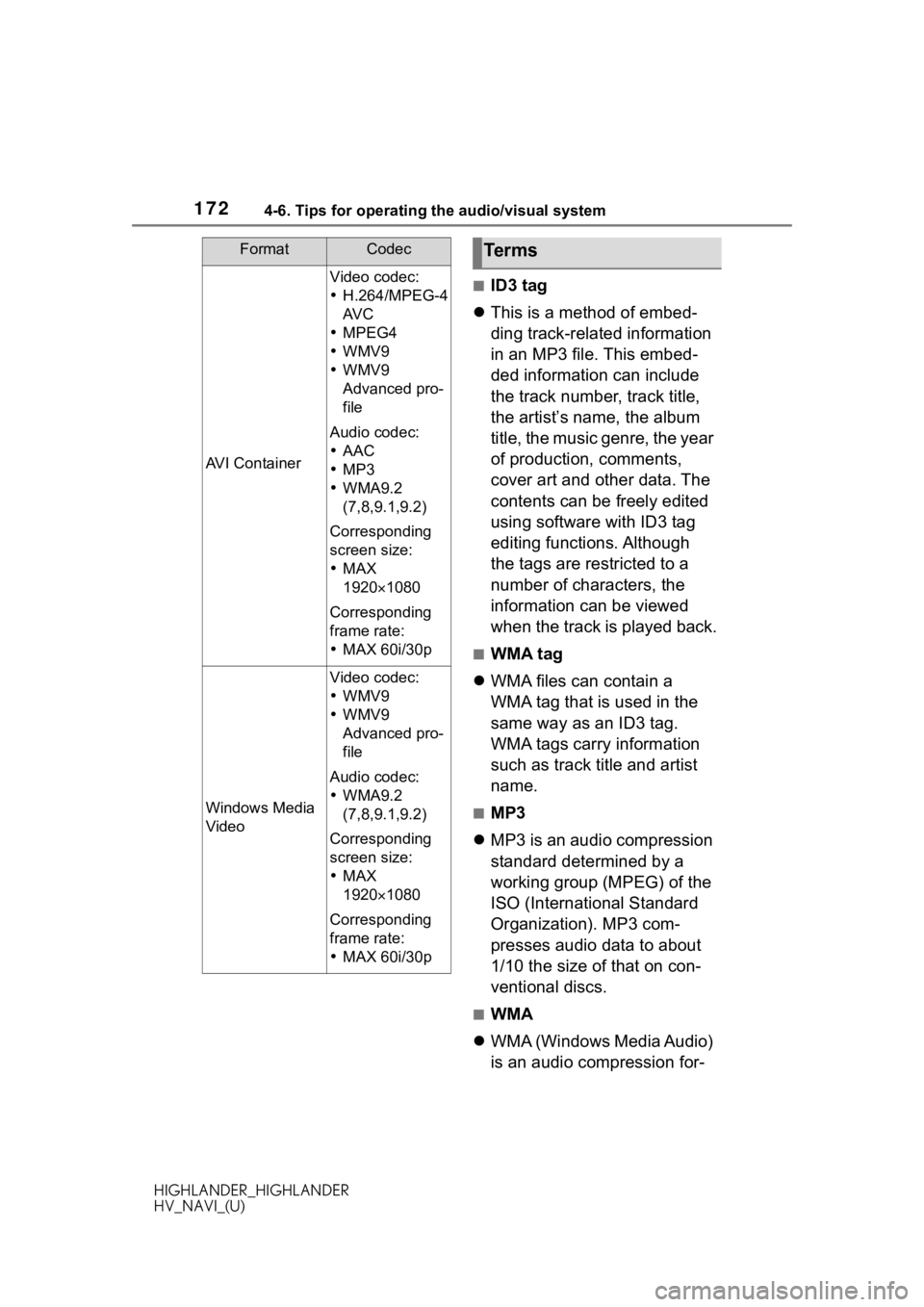
1724-6. Tips for operating the audio/visual system
HIGHLANDER_HIGHLANDER
HV_NAVI_(U)
■ID3 tag
This is a method of embed-
ding track-related information
in an MP3 file. This embed-
ded information can include
the track number, track title,
the artist’s name, the album
title, the music genre, the year
of production, comments,
cover art and other data. The
contents can be freely edited
using software with ID3 tag
editing functions. Although
the tags are restricted to a
number of characters, the
information can be viewed
when the track is played back.
■WMA tag
WMA files can contain a
WMA tag that is used in the
same way as an ID3 tag.
WMA tags carry information
such as track title and artist
name.
■MP3
MP3 is an audio compression
standard determined by a
working group (MPEG) of the
ISO (International Standard
Organization). MP3 com-
presses audio data to about
1/10 the size of that on con-
ventional discs.
■WMA
WMA (Windows Media Audio)
is an audio compression for-
AVI Container
Video codec:
H.264/MPEG-4
AV C
MPEG4
WMV9
WMV9
Advanced pro-
file
Audio codec:
AAC
MP3
WMA9.2
(7,8,9.1,9.2)
Corresponding
screen size:
MAX
19201080
Corresponding
frame rate:
MAX 60i/30p
Windows Media
Video
Video codec:
WMV9
WMV9
Advanced pro-
file
Audio codec:
WMA9.2
(7,8,9.1,9.2)
Corresponding
screen size:
MAX
19201080
Corresponding
frame rate:
MAX 60i/30p
FormatCodecTerms
Page 173 of 402
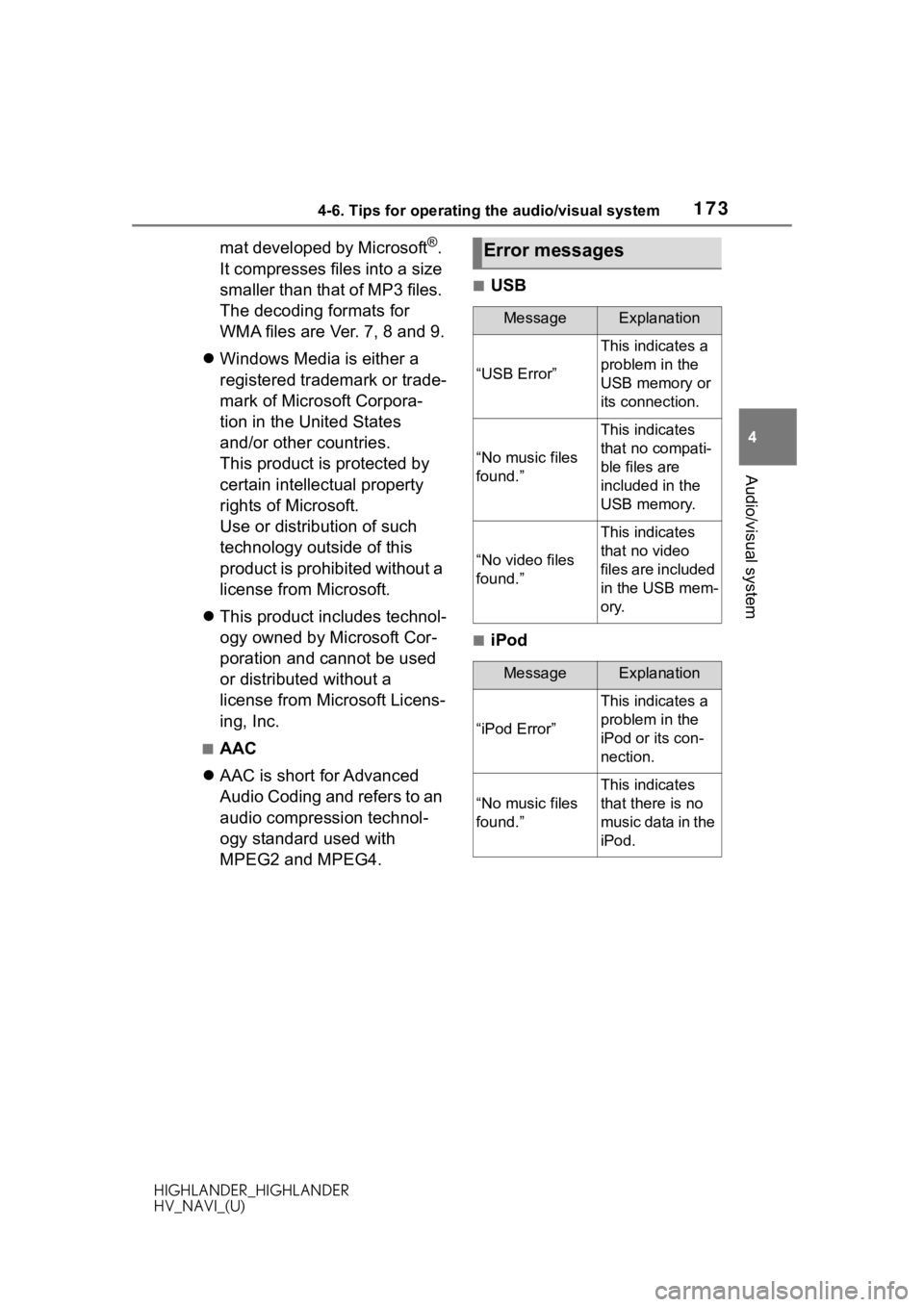
1734-6. Tips for operating the audio/visual system
HIGHLANDER_HIGHLANDER
HV_NAVI_(U)
4
Audio/visual system
mat developed by Microsoft®.
It compresses files into a size
smaller than that of MP3 files.
The decoding formats for
WMA files are Ver. 7, 8 and 9.
Windows Media is either a
registered trademark or trade-
mark of Microsoft Corpora-
tion in the United States
and/or other countries.
This product is protected by
certain intellectual property
rights of Microsoft.
Use or distribution of such
technology outside of this
product is prohibited without a
license from Microsoft.
This product includes technol-
ogy owned by Microsoft Cor-
poration and cannot be used
or distributed without a
license from Microsoft Licens-
ing, Inc.
■AAC
AAC is short for Advanced
Audio Coding and refers to an
audio compression technol-
ogy standard used with
MPEG2 and MPEG4.
■USB
■iPod
Error messages
MessageExplanation
“USB Error”
This indicates a
problem in the
USB memory or
its connection.
“No music files
found.”
This indicates
that no compati-
ble files are
included in the
USB memory.
“No video files
found.”
This indicates
that no video
files are included
in the USB mem-
ory.
MessageExplanation
“iPod Error”
This indicates a
problem in the
iPod or its con-
nection.
“No music files
found.”
This indicates
that there is no
music data in the
iPod.
Page 219 of 402
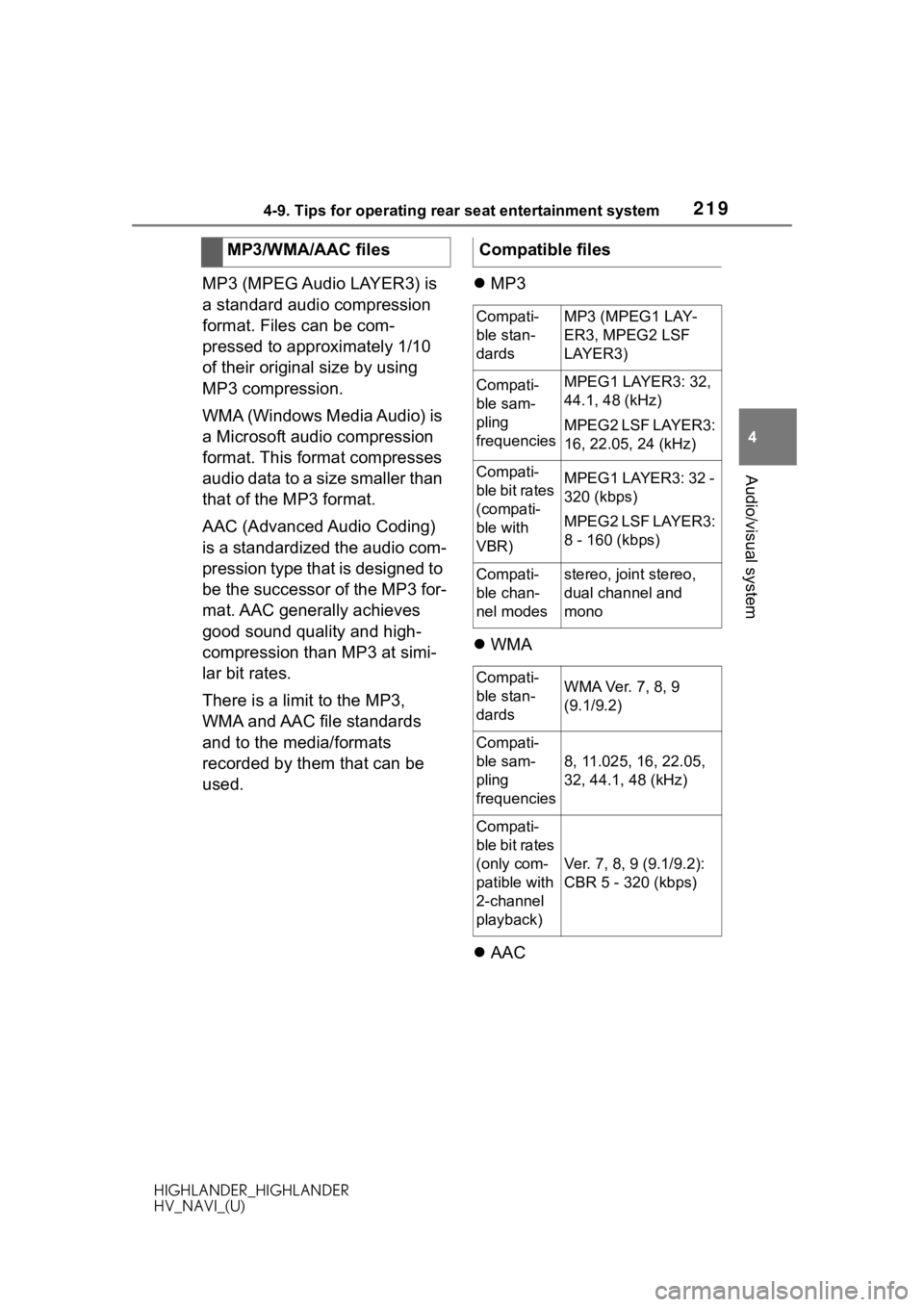
2194-9. Tips for operating rear seat entertainment system
HIGHLANDER_HIGHLANDER
HV_NAVI_(U)
4
Audio/visual system
MP3 (MPEG Audio LAYER3) is
a standard audio compression
format. Files can be com-
pressed to approximately 1/10
of their original size by using
MP3 compression.
WMA (Windows Media Audio) is
a Microsoft audio compression
format. This format compresses
audio data to a size smaller than
that of the MP3 format.
AAC (Advanced Audio Coding)
is a standardized the audio com-
pression type that is designed to
be the successor of the MP3 for-
mat. AAC generally achieves
good sound quality and high-
compression than MP3 at simi-
lar bit rates.
There is a limit to the MP3,
WMA and AAC file standards
and to the media/formats
recorded by them that can be
used.
MP3
WMA
AAC
MP3/WMA/AAC files
Compatible files
Compati-
ble stan-
dardsMP3 (MPEG1 LAY-
ER3, MPEG2 LSF
LAYER3)
Compati-
ble sam-
pling
frequenciesMPEG1 LAYER3: 32,
44.1, 48 (kHz)
MPEG2 LSF LAYER3:
16, 22.05, 24 (kHz)
Compati-
ble bit rates
(compati-
ble with
VBR)MPEG1 LAYER3: 32 -
320 (kbps)
MPEG2 LSF LAYER3:
8 - 160 (kbps)
Compati-
ble chan-
nel modesstereo, joint stereo,
dual channel and
mono
Compati-
ble stan-
dardsWMA Ver. 7, 8, 9
(9.1/9.2)
Compati-
ble sam-
pling
frequencies
8, 11.025, 16, 22.05,
32, 44.1, 48 (kHz)
Compati-
ble bit rates
(only com-
patible with
2-channel
playback)
Ver. 7, 8, 9 (9.1/9.2):
CBR 5 - 320 (kbps)
Page 224 of 402
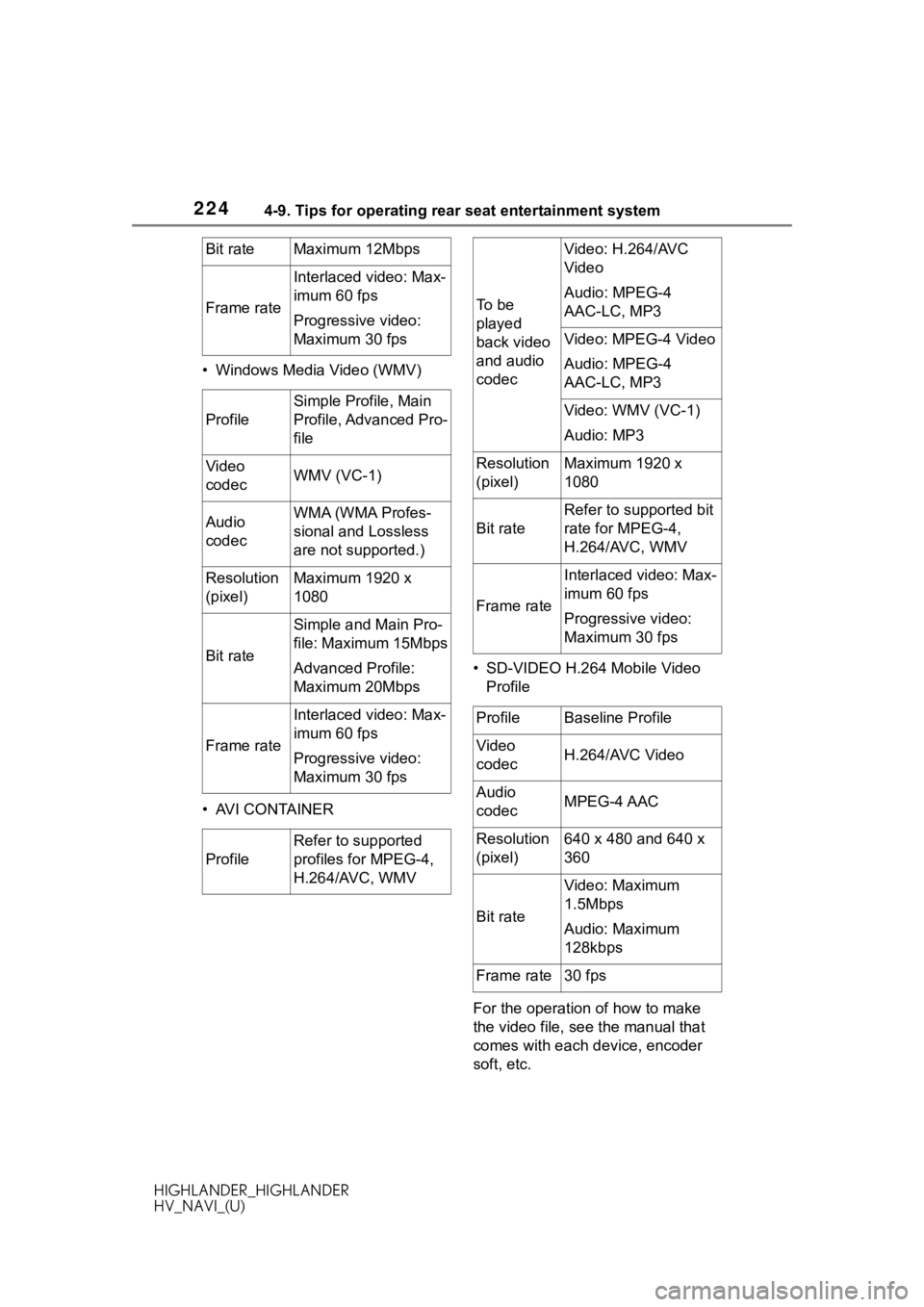
2244-9. Tips for operating rear seat entertainment system
HIGHLANDER_HIGHLANDER
HV_NAVI_(U)• Windows Media Video (WMV)
• AVI CONTAINER
• SD-VIDEO H.264 Mobile Video
Profile
For the operation of how to make
the video file, see the manual that
comes with each device, encoder
soft, etc.
Bit rateMaximum 12Mbps
Frame rate
Interlaced video: Max-
imum 60 fps
Progressive video:
Maximum 30 fps
Profile
Simple Profile, Main
Profile, Advanced Pro-
file
Video
codecWMV (VC-1)
Audio
codecWMA (WMA Profes-
sional and Lossless
are not supported.)
Resolution
(pixel)Maximum 1920 x
1080
Bit rate
Simple and Main Pro-
file: Maximum 15Mbps
Advanced Profile:
Maximum 20Mbps
Frame rate
Interlaced video: Max-
imum 60 fps
Progressive video:
Maximum 30 fps
Profile
Refer to supported
profiles for MPEG-4,
H.264/AVC, WMV
To b e
played
back video
and audio
codec
Video: H.264/AVC
Video
Audio: MPEG-4
AAC-LC, MP3
Video: MPEG-4 Video
Audio: MPEG-4
AAC-LC, MP3
Video: WMV (VC-1)
Audio: MP3
Resolution
(pixel)Maximum 1920 x
1080
Bit rate
Refer to supported bit
rate for MPEG-4,
H.264/AVC, WMV
Frame rate
Interlaced video: Max-
imum 60 fps
Progressive video:
Maximum 30 fps
ProfileBaseline Profile
Video
codecH.264/AVC Video
Audio
codecMPEG-4 AAC
Resolution
(pixel)640 x 480 and 640 x
360
Bit rate
Video: Maximum
1.5Mbps
Audio: Maximum
128kbps
Frame rate30 fps
Page 226 of 402
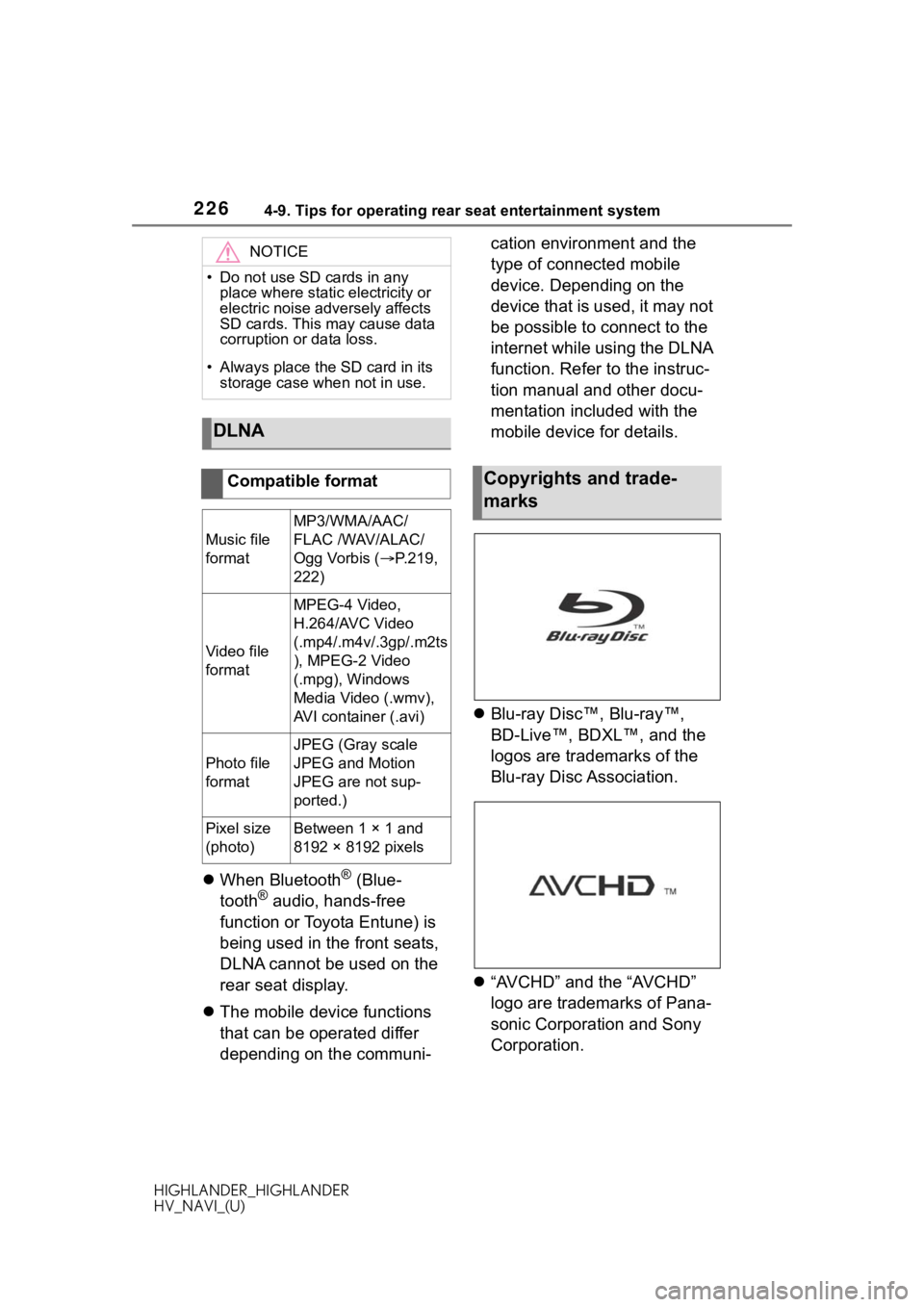
2264-9. Tips for operating rear seat entertainment system
HIGHLANDER_HIGHLANDER
HV_NAVI_(U)
When Bluetooth® (Blue-
tooth® audio, hands-free
function or Toyota Entune) is
being used in the front seats,
DLNA cannot be used on the
rear seat display.
The mobile device functions
that can be operated differ
depending on the communi- cation environment and the
type of connected mobile
device. Depending on the
device that is used, it may not
be possible to connect to the
internet while using the DLNA
function. Refer to the instruc-
tion manual and other docu-
mentation included with the
mobile device for details.
Blu-ray Disc™, Blu-ray™,
BD-Live™, BDXL™, and the
logos are trademarks of the
Blu-ray Disc Association.
“AVCHD” and the “AVCHD”
logo are trademarks of Pana-
sonic Corporation and Sony
Corporation.
NOTICE
• Do not use SD cards in any
place where static electricity or
electric noise adversely affects
SD cards. This may cause data
corruption or data loss.
• Always place the SD card in its storage case when not in use.
DLNA
Compatible format
Music file
format
MP3/WMA/AAC/
FLAC /WAV/ALAC/
Ogg Vorbis ( P.219,
222)
Video file
format
MPEG-4 Video,
H.264/AVC Video
(.mp4/.m4v/.3gp/.m2ts
), MPEG-2 Video
(.mpg), Windows
Media Video (.wmv),
AVI container (.avi)
Photo file
format
JPEG (Gray scale
JPEG and Motion
JPEG are not sup-
ported.)
Pixel size
(photo)Between 1 × 1 and
8192 × 8192 pixels
Copyrights and trade-
marks
Page 228 of 402

2284-9. Tips for operating rear seat entertainment system
HIGHLANDER_HIGHLANDER
HV_NAVI_(U)
with the MPEG-4 Visual Stan-
dard, AVC Standard and VC-1
Standard
(“MPEG-4/AVC/VC-1 Video”)
and/or (ii) decode
MPEG-4/AVC/VC-1 Video
that was encoded by a con-
sumer engaged in a personal
activity and/or was obtained
from a video provider licensed
to provide MPEG-4/AVC/VC-1
Video. No license is granted
or shall be implied for any
other use. Additional informa-
tion may be obtained from
MPEG LA, L.L.C. See
http://www.mpegla.com
.
WMA (Windows Media
Audio), Microsoft, Windows,
and Windows Media are the
registered trademarks of Mic-
rosoft Corporation in the U.S.
and other countries. This
product is protected by certain
intellectual property rights of
Microsoft Corporation and
third parties. Use or distribu-
tion of such technology out-
side of this product is
prohibited without a license
from Microsoft or an autho-
rized Microsoft subsidiary and
third parties.
This item incorporates copy
protection technology that is
protected by U.S. patents and
other intellectual property
rights of Rovi Corporation.
Reverse engineering and dis- assembly are prohibited.
Oracle, Java and all
Java-based trademarks and
logos are trademarks or regis-
tered trademarks of Oracle
and/or its affiliates. Other
names may be trademarks of
their respective owners.
Page 244 of 402

2445-1. Voice command system operation
HIGHLANDER_HIGHLANDER
HV_NAVI_(U)
5-1.Voice command system operation
■Steering switchTa l k s w i t c h
Voice command system:
• Press the talk switch to start the voice command system. To can-
cel voice command, press and
hold the talk switch.
When an Apple CarPlay/Android
Auto connection is established:
*
• Press and hold the talk switch to start Siri/Google Assistant. To
cancel Siri/Google Assistant,
press the talk switch.
• Press the talk switch to start the voice command system.
*: This function is not made avail-able in some countries or areas.
■Microphone
It is unnecessary to speak
directly into the microphone
when giving a command.
●Voice commands may not be rec-
ognized if:
• Spoken too quickly.
• Spoken at a low or high volume.
• The windows are open.
• Passengers are talking while
voice commands are spoken.
• The fan speed of the air condition- ing system is set at high.
• The air conditioning vents are turned towards the microphone.
●In the following c onditions, the
system may not recognize the
command properly and using
voice commands may not be pos-
sible:
• The command is incorrect or
unclear. Note that certain words,
accents or speech patterns may
be difficult for the system to recog-
nize.
• There is excessive background noise, such as wind noise.
●Normally, it is necessary to wait
for a beep before saying a com-
mand. To enable th e ability to talk
over prompts and say commands
before the beep, enable the voice
prompt interrupt function. ( P. 7 1 )
●This system may not operate
immediately after the engine
switch
or ON.
Voice command sys-
tem
The voice command sys-
tem enables the radio,
phone dialing, etc. to be
operated using voice com-
mands. Refer to the com-
mand list for samples of
voice commands. ( P.248)
Using the voice command
system
A
Page 254 of 402

2545-2. Mobile Assistant operation
HIGHLANDER_HIGHLANDER
HV_NAVI_(U)commands, the Mobile Assistant
feature will automatically end to
complete the re
quested action.
The volume of the Mobile
Assistant can be adjusted
using the “POWER VOL-
UME”/“PWR/VOL” knob or
steering wheel volume control
switches. The Mobile Assis-
tant and phone call volumes
are synchronized.
●While a phone call is active, the
Mobile Assistant cannot be used.
●If using the navig ation feature of
the cellular phone, ensure the
active audio source is Bluetooth
®
audio or iPod in order to hear turn
by turn direction prompts.
●Wait for the listening beeps before
using the Mobile Assistant.
●The Mobile Assistant may not rec-
ognize commands in the following
situations:
• Spoken too quickly.
• Spoken at a low or high volume.
• The windows are open.
• Passengers are talking while the Mobile Assistant is being used.
• The fan speed of the air condition-
ing system is set at high.
• The air conditioning vents are
turned toward the microphone.